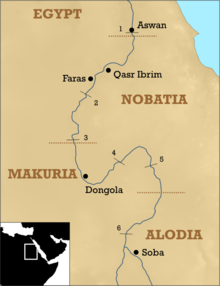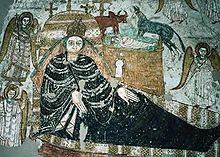Faras




Faras, known in ancient times as Pachoras, was a major city in Lower Nubia in modern Egypt. The site of the city was flooded by Lake Nasser in the 1960s, and is now permanently underwater. Before this flooding, extensive archeological work was conducted by a Polish archeological team.
Dating back to the A Group period, the town was a major centre during the Meroitic period, and was the site of a major temple. During the period of Egyptian control over Nubia, Faras became an Egyptian administrative centre and, located upriver from Abu Simbel, Egyptian cultural influences were prominent.
The city reached its height during the Christian period of Nubia, and Faras became the capital of the state of Nobatia. When Nobatia was absorbed into Makuria, it remained the most prominent centre in the north. One of the most important discoveries from this period was the town's cathedral. The cathedral had been completely filled with sand, preserving the large number of intricate paintings on its walls. These paintings are the best surviving examples of Christian Nubian art. They depict a number of well-known Biblical scenes and also portraits of various bishops of Faras and monarchs. These paintings were salvaged and are today on display in Warsaw and Khartoum. A major pottery works was also found at Faras, which likely made much of the high quality pottery of the Makurain Golden Age.
In the turbulent, later years of Christian Nubia, Faras seems to have declined, and the administrative centre switched to the more easily defended centre of Qasr Ibrim.
External links
- Exhibition on Faras, Vienna 2002
- Medieval Nubia
